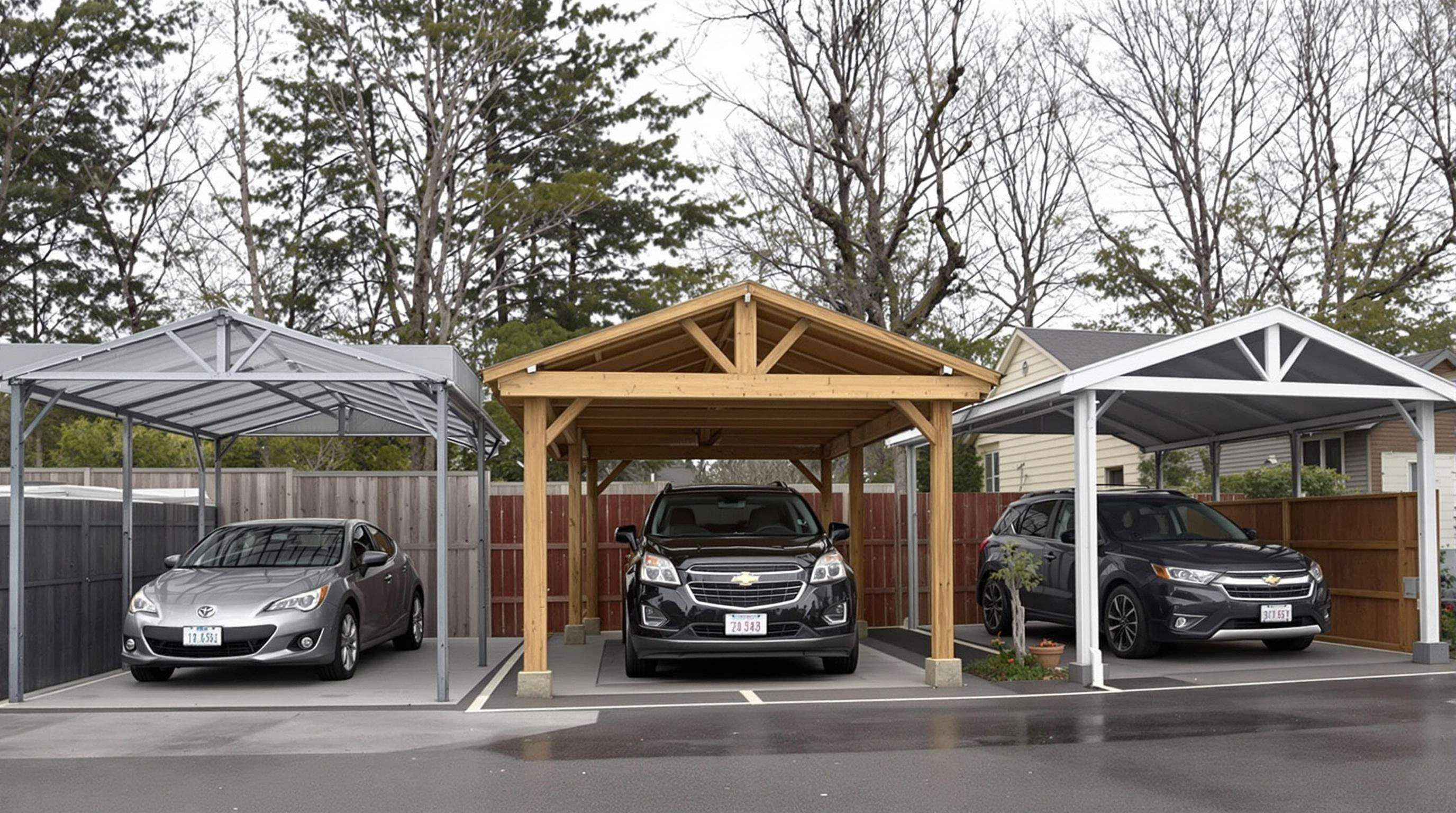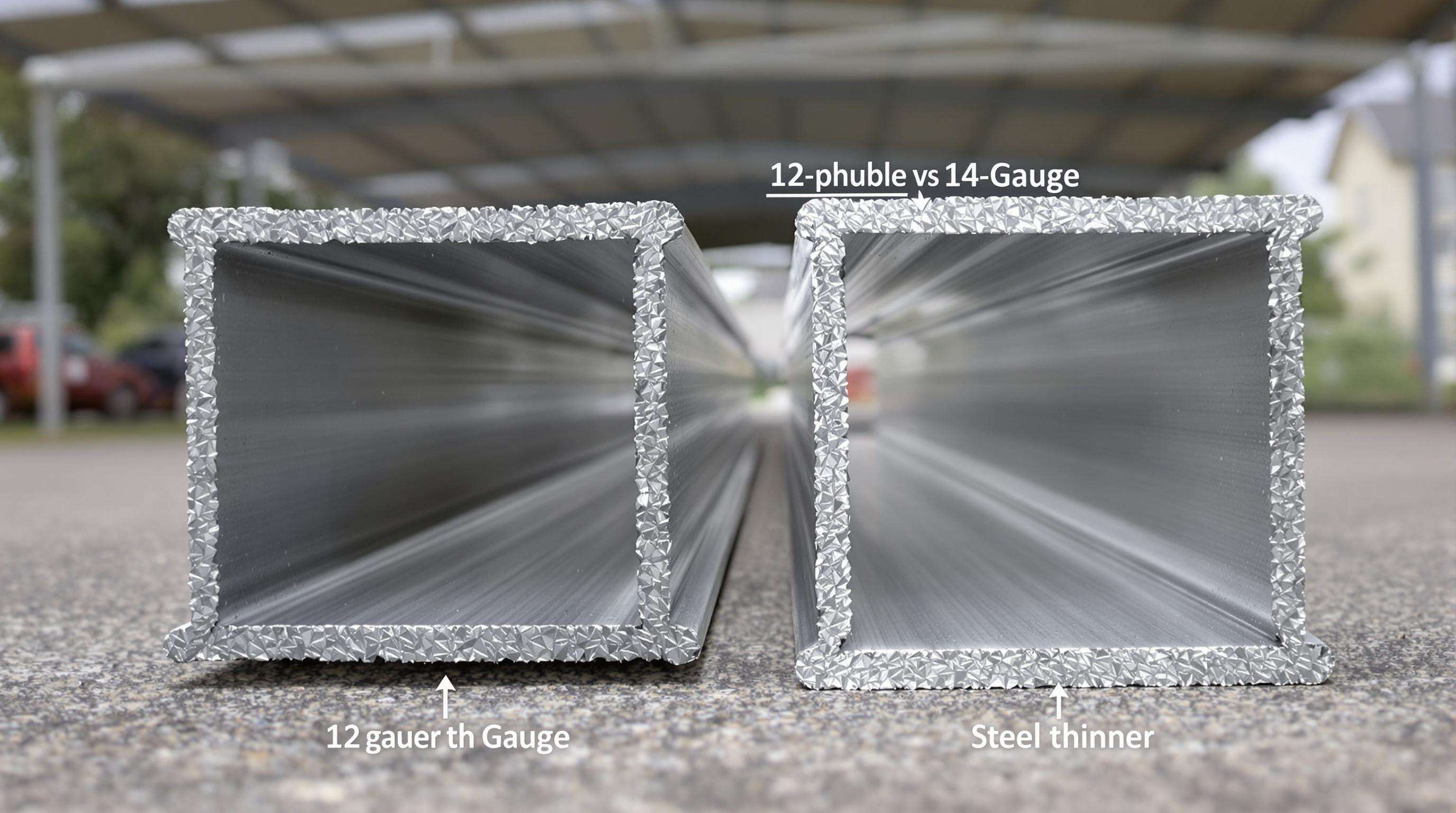Steel frame carports are emerging as the dominant choice for property owners due to their durability, cost efficiency, and versatility. Unlike traditional wood or aluminum structures, steel carports provide weather-resistant, customizable shelters that serve multiple purposes beyond vehicle protection.
Growing Popularity in Residential and Commercial Applications
Homeowners now use steel carports for EV charging stations, outdoor workshops, and RV storage, while businesses leverage them for warehouse overflow and equipment protection. Commercial adopters benefit from faster permitting processes due to standardized engineering certifications.
Steel vs. Wood vs. Aluminum: Material Advantages for Carports

| Factor | Steel | Wood | Aluminum |
|---|---|---|---|
| Strength | 12-gauge supports 65 PSF snow loads | Warps under 30 PSF | Dents at 45 mph winds |
| Maintenance | Annual inspection | Bi-annual sealing | Corrosion cleaning |
| Lifespan | 25+ years | 10-15 years | 15-20 years |
| Cost Efficiency | $0.18/sf annual upkeep | $0.42/sf annual upkeep | $0.27/sf annual upkeep |
Steel's galvanized coatings prevent rust, addressing the top concern among buyers. Wood requires costly termite treatments, while aluminum struggles in severe weather conditions.
Key Market Trends Driving Steel Carport Adoption in 2025
- Hybrid Workspaces: Remote workers use carports as outdoor offices, fueling demand for insulated, pre-wired models.
- Climate Resilience: Updated building codes mandate steel framing in flood/wildfire zones.
- Prefab Dominance: Steel carports are delivered faster than custom wood builds, cutting labor costs significantly.
The 2025 Prefab Construction Report confirms steel carports will dominate the North American market by Q4.
Durability and Weather Resistance of Steel Frame Carports
Understanding Steel Gauge: 12-Gauge vs. 14-Gauge Strength Differences

Steel thickness directly impacts resilience—12-gauge (2.65 mm) offers higher snow load capacity (70 lb/sq ft) and wind resistance (150 mph) than 14-gauge (1.90 mm).
Critical Performance Comparison
| Gauge | Thickness | Snow Load Capacity | Wind Rating | Lifespan |
|---|---|---|---|---|
| 12 | 0.1046" | 70 lb/sq ft | 150 mph | 20-25 years |
| 14 | 0.0747" | 23 lb/sq ft | 90 mph | 10-15 years |
Studies show 12-gauge carports withstand severe weather far better than thinner alternatives.
Engineering and Structural Design of Reliable Steel Carports
Core Structural Components: Bows, Purlins, Rafters, and Trusses
Steel carports rely on bows, purlins (roof crossbeams), and trusses for stability. Industry standards recommend 12-gauge steel for optimal load-bearing capacity.
Frame Spacing and Roof Pitch: Optimizing Load Distribution
Narrower spacing (4-5 feet) improves snow load capacity, while steeper roof pitches (≥3:12 slope) enhance water runoff and wind resistance.
| Frame Spacing | Snow Load Capacity | Wind Rating |
|---|---|---|
| 4' centers | 40 psf | 130 mph |
| 5' centers | 25 psf | 110 mph |
Anchoring Systems for High Winds, Snow Loads, and Seismic Zones
Strategies include auger-style anchors (hurricane zones), concrete piers (snowy climates), and seismic isolation bearings (earthquake-prone areas).
Case Study: Steel Carport Performance in Hurricane-Prone Areas
A FEMA report found compliant steel carports (12-gauge, 4' spacing, deep anchors) survived Hurricane Laura with minimal damage compared to non-compliant structures.
Cost-Effectiveness and Long-Term Value of Steel Frame Carports
Upfront Costs vs. 20-Year Maintenance and Repair Savings
Steel carports offer long-term savings with minimal maintenance costs:
| Upfront Cost | 20-Year Maintenance Cost | |
|---|---|---|
| Steel Carport | $4,200 avg. | $1,100 avg. |
| Wood Structure | $5,800 avg. | $12,400 avg. |
| Aluminum Carport | $3,900 avg. | $6,300 avg. |
Source: 2024 Construction Materials Cost-Benefit Analysis Report
Steel Carports vs. Traditional Garages: A Value Comparison
Steel carports provide comparable protection at 45-60% lower cost than garages, with lower insurance premiums and relocation flexibility.
| Construction Time | Permitting Needs | Relocation Potential | |
|---|---|---|---|
| Steel Carport | 1-3 days | Minimal | Fully relocatable |
| Traditional Garage | 8-14 weeks | Extensive | Permanent structure |
Customization and Functional Flexibility in 2025 Steel Carport Designs
Sizing, Height Options, and Color Choices for Aesthetic Fit
Available widths range from 12' to 40', with powder-coated finishes in 20+ colors for long-lasting appeal.
Roof Styles Compared: A-Frame, Vertical, and Round Top
- A-frame: Best for snow-heavy regions (6:12 pitch).
- Vertical roofs: Ideal for rain runoff.
- Round top: Extra headroom for workshops.
Adding Walls, Doors, and Insulation for Multi-Purpose Use
Enclose with steel or polycarbonate panels, and add insulation for temperature stability. Over 68% of buyers modify structures for dual-purpose use.
FAQ Section
What makes steel frame carports more durable than wood or aluminum?
Steel frame carports are more durable due to their resistance to weather conditions, pest damage, and structural integrity. Steel’s galvanized coatings prevent rust, unlike wood which requires frequent termite treatments and aluminum which may dent under strong winds.
Why are steel frame carports considered cost-efficient?
Steel frame carports have lower maintenance costs and offer long-term savings compared to wood and aluminum. They are also faster to install, reducing labor costs and permitting requirements.
How customizable are steel carports?
Steel carports offer various sizing, height options, and color choices. They can also be fitted with different roof styles, walls, doors, and insulation, allowing them to serve multiple purposes beyond vehicle protection.
Are steel carports suitable for extreme weather conditions?
Yes, especially 12-gauge steel carports which are designed to withstand high snow loads and strong winds, making them ideal for areas prone to extreme weather.
Table of Contents
- Growing Popularity in Residential and Commercial Applications
- Steel vs. Wood vs. Aluminum: Material Advantages for Carports
- Key Market Trends Driving Steel Carport Adoption in 2025
- Durability and Weather Resistance of Steel Frame Carports
- Understanding Steel Gauge: 12-Gauge vs. 14-Gauge Strength Differences
- Engineering and Structural Design of Reliable Steel Carports
- Core Structural Components: Bows, Purlins, Rafters, and Trusses
- Frame Spacing and Roof Pitch: Optimizing Load Distribution
- Anchoring Systems for High Winds, Snow Loads, and Seismic Zones
- Case Study: Steel Carport Performance in Hurricane-Prone Areas
- Cost-Effectiveness and Long-Term Value of Steel Frame Carports
- Upfront Costs vs. 20-Year Maintenance and Repair Savings
- Steel Carports vs. Traditional Garages: A Value Comparison
- Customization and Functional Flexibility in 2025 Steel Carport Designs
- Sizing, Height Options, and Color Choices for Aesthetic Fit
- Roof Styles Compared: A-Frame, Vertical, and Round Top
- Adding Walls, Doors, and Insulation for Multi-Purpose Use
- FAQ Section

